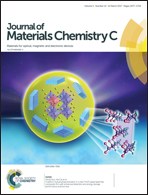A distinct mutual phase transition in a new PVDF based lead-free composite film with enhanced dielectric and energy storage performance and low loss
Abstract
Environment-friendly polyvinylidene fluoride (PVDF) based composite films were fabricated by using a high permittivity lead-free Ba(Sn,Ti)O3–(Ba,Ca)TiO3 (BCTS) ceramic filler with a special ‘tricritical’ phase structure. The dielectric and energy storage performance and the microstructure evolution of the samples were investigated. Infrared spectroscopy, X-ray diffraction (XRD) and synchrotron radiation XRD results showed that the plate-shaped BCTS nanopowders induced a distinct mutual phase transition but not the usual nonpolar to polar one. Consequently, a largely increased dielectric constant (εr), a higher energy density (∼4 J cm−3 at 200 kV mm−1) and a dielectric loss even lower than that of neat PVDF were simultaneously achieved with a very small loading (0.59 vol%) of BCTS. Theoretical simulations showed that εr was well predicted by the effective medium theory and the modified Lichtenecker model, implying the important role of the size and shape of filler particles in performance. A special transitional stratification layer observed around the BCTS particles implies heterogeneous nucleation of the polymer. A mechanism due to the interplay of crystallization and possible stress and electrostatic interaction was proposed to explain the phase evolution. The results may provide new insight into the understanding of the structural characteristics of the composites and a new strategy for tailoring their performance.



 Please wait while we load your content...
Please wait while we load your content...